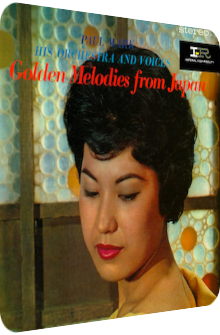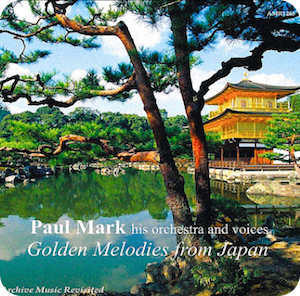
Paul Mark
Golden Melodies
From Japan
1961
Golden Melodies From Japan by Paul Mark is the Honolulu-based pianist and organist’s second album where he carves out his vision of Japanese Exotica in the whopping amount of 14 tracks. Released on Imperial Records in 1961, it is a very important work (though not many people have heard it, let alone of it), as it embodies an interstitial position: it sits right in-between Mark’s much better known East To West (1961) which is a live recording with a septet at Honolulu’s Oasis Night Club and supercharged with galactic organ textures, koto, shamisen and guitar twangs as well as bongo blebs on the one hand, and his quirkily titled edutainment corker 12½ Geishas Must Be Right (1963) on the other hand which features orchestral strings, harps and vocals in both Japanese and English en masse.
Golden Melodies From Japan sits in the middle of these two works in that it features the koto, organ and bongos from the former work and unites them with the strings and the choir of geishas called The Queen Bees from the latter. Said Quen Bees are lead singer May Murakami plus her cohorts Nancy Moritomo and Darlene Yoshimoto who appear in 50% of the songs, with the other half comprising of instrumentals. This is another marker that shows the stylistic duality the album absorbs… and foreshadows. It is a nobrainer for fans of Japanese Exotica in general, but of particular interest to those, I presume, who love the classical setups of exotic Jazz quartets or quintets and the ubiquitous gentle orchestration of the material at the same time. Golden Melodies From Japan offers the best of both worlds (and of Mark’s other two albums). Here is a closer look at what one can expect, complete with supplemental information and translations of the track titles thanks to Jan Werkmann.

No woman, no cry: the digital reissue of Golden Melodies From Japan features a beautiful vista.
That Golden Melodies From Japan really sits in-between Paul Mark’s two primary styles is immediately showcased in the traditional Kompira Fune (the boat from Kompira), a song about the very city from the island of Shikoku. The anacrusis is delivered by dreamy harp twangs which resemble Mark’s 12½ Geishas album, but the following uplifting intertwinement draws much more from East To West and realizes this concoction yet again with symphonic textures: Japanese rain sticks, pizzicato strings, pentatonic marimba and vibraphone droplets, double bass billows, sparsely used trombones, yearning flutes, short guitar intersections as well as bone-crushing drums create a positively messy kaleidoscope of different patterns… in less than 100 seconds! The mood is uplifting and delivers the perfect feeling of Exotica!
The following Mizuiro No Waltz, originally written by Toroku Takaki and translatable as the waltz made of watercolors, is much more laid-back and yearning; Paul Mark augments the string washes with harps, the trombone wafts melancholically around May Murakami’s short windchime-interspersed vocals. Rounded off by Mark’s very own piano accompaniment, the gorgeous Yagi Bushi (the warrior/samurai from Yagi) is next, made popular in the late 50’s by Chiemi Eri. This song is strikingly Japanese, beatific and exotic. It is a Folk tune about said samurai from the Niigata prefecture and enchants with its sophisticated and amicable percussion shrapnel made of rhythm xylophones, softened hi-hats bongos and congas. These are further illumined by the glissando of mystical vibraphones, a gorgeous interplay of two flutes and flawlessly timed guitar enmeshments. Oscillating between freedom, wideness and bliss, Yagi Bushi is a standout arrangement.
If you favor the organ-centric sound of Paul Mark off East To West, look no further, as Sado Okesa could well be a leftover of that live session. A traditional Folk dance about the island of Sado, the ritualistic rhythm in 6/8 time enthralls as mercilessly as Mark’s organ globs and flumes, the multitudinous prominent sunset-colored koto twangs, the polyphonic flute movements, the muted trombone in the background and the dead-serious and devoted performance by The Queen Bees. This traditional song is of course exotified by the organ layers and yet keeps its aura of realness, a rare feat in the plastic worlds of Exotica! Up next is Mujo No Yume, written by Shunichi Sasaki and roughly translatable as a fugacious dream. This tune remains very close stylistically to Mark’s 12½ Geishas LP. The synergy of the symphonic string breezes with the dreamy guitars, the adjacent harps and vibes, Murakami’s wordless vocals as well as Mark’s central performance on the piano make this a warmhearted song, enormously gentle and benign.
Whereas Nobuki Takeoka’s Shina No Yoru (one night in China) sounds like a Martin Denny arrangement due to its gaudily Chinese melodies and textures, the constant appearance of the Japanese banjo called shamisen, the afterglow of the gongs as well as the occurrence of pointillistic marimbas, it is the finale of side A that is a real treat and stylistically far off the album’s endemics: Yoichi Suzuki’s Tokyo Dodon’pa Musume features the – back then latest – craze of the so-called dodon’pa rhythm, cheeky vocals by The Queen Bees, a catchy chorus to cherish, guitar twangs and friendly brass bursts. This is a camouflaged big band critter, presented in a genteel manner, and solely included in order to cater to the Pop masses.
Side B launches with a tune that is quite known in Exotica circles: the children’s song Shojoji about frolicking kids in a moonlit church backyard. Its joyous physiognomy is highly compatible with the album’s setup, the melody is immediately recognizable, with the shamisen-and-guitar couples and flute tones leaving enough room to let the double bass billows shine. The moon-simulating glockenspiels make this a cheerful classic that is suitable for Occidental ears as well; Warren Barker’s take included on A Musical Touch Of Far Away Places (1959) offers a more lachrymose version that is heavier on the string side. Coming up next is possibly the definite inclusion on Golden Melodies From Japan, a stupefyingly fantastic-phantasmagoric dreamlike state transformed into music: Gion Kouta is a ditty dedicated to Kyoto’s district Gion which is famous to this day for its geisha tradition and, er, catwalks. What Paul Mark and his orchestra create is bewitching and magical, as he interweaves all the textures he can get hold of in a semi-mournful capsule of longing and yearning. I better not describe it detailedly, as I do not want to destroy its magic, but rest assured that its movements of stringed instruments are maximally alluring and convincing, as are May Murakami’s pristine vocals. The best track of the album has it all, is densely layered and one piece to guard. Fans of the admittedly artificial genre Ambient Exotica will be delighted.
The traditional Dare Yori Mo Kimi Wo Aisu (I love you only) not only wins the prize for the longest title, it also accomplishes to establish the atmosphere of a Jazz bar better than any other song of this album. Rufescent brass bursts, piano and organ susurrations as well as Crime Jazz-oriented double bass backings altogether form a splendid backdrop for The Queen Bees’ polyphony. The dun-colored tune resurrects the shadier moments hued in twilight on the pianist’s East To West, even though that album does not feature horns. The next tune is again superbly convincing, although it inherits the masked racism of rural Japan: Koi San No Love Call is about the love call of bushmen (or what Japanese people perceived as such back in the 60’s), and what a coincidence, isn’t this also an omnipresent theme in the Exotica genre? The composition itself is by no means tribal or frantic. It is diametrically opposite thanks to its fluttering dragonfly-like string flaps, the legato washes and translucent mallet instruments. The vibrant guitar chords emanate thermal heat, the harmonious overtones are monolithic. A transfiguration of the African steppes which are unrecognizable in this arrangement.
While Suzu Kake No Michi is about the longevity of the Oriental plane and its long way to prosperity – poignantly shown via a dualistic seriousness, many ruddish piano tones and Murakami’s yearning vocals –, the nature-driven Oshima Bushi is about the samurai in Oshima, a prefecture of Hokkaido. A special arrangement due to its long field recording of ocean waves, Shinto flute melodies, tempo boosts, galloping beat structure and bewitching textures of strings, gongs and glockenspiels, it eventually leads to the finale Sumire No Hana (violet flowers), a clear cut Pop hymn which, of course, relies on The Queen Bees, opalescent organ serpentines and a silkened lead trumpet.
If you take the title of Golden Melodies From Japan literally, the album is a blatant, but oh so sweet lie, for anything is particularly golden about the selected songs. Oddly enough, all of Paul Mark’s other albums feature ditties and Folk material that is much more golden than it is the case here: Sakura, Oedo Mehon Bashi, Wakare No Isochidori or Ringo Oiwake have been interpreted by luminaries such as Arthur Lyman, Martin Denny, Rene Paulo and Werner Müller aka Ricardo Santos, but none of these tunes appears here. Only Shojoji crosses the Exotica fans’ path sooner or later in the form of Warren Barker’s rendition that is mentioned above. And now to the good thing: this does not matter at all! Golden Melodies From Japan is a fantastic piece of Japanese Exotica, and one of the standout albums to own.
Why then is it not often mentioned by Exotica fans and experts? You tell me, as I would love to know the answer. From the much better known East To West, it is only a small step to check out the subsequent work. Golden Melodies From Japan is also worthwhile from a comparative, contrastive or a musicologist’s viewpoint, as it showcases the nuts and bolts of Paul Mark’s cultural understanding. Here, he does not have an educational mandate as he does on 12½ Geishas Must Be Right, there are no English lyrics sung anywhere in the songs itself, only a few vestiges of English vocabulary in the song titles. Since next to nothing is known about these songs even by diehard Exotica fans, the album continues to emit a mystical aura. The wealth of instruments, gorgeous melodies and vocals is breathtaking! Stellar highlights include the dreamy mirage Gion Kouta and the string-soaked Koi San No Love Call, but everything else is also convincing here. Super-recommended to fans of Japanese Exotica, and yes, the serious tradition of the songs is no obstacle and never in Paul Mark’s way, since he embraces and glorifies it in exotic arrangements. And eureka, the album has been digitally reissued and sounds great! One of the greatest Exotica albums no one cares about (yet), Golden Melodies From Japan could eventually enter the canon in the far future. Why not jump on the bandwagon today? I promise you that it will be worth your while!
Exotica Review 277: Paul Mark – Golden Melodies From Japan (1961). Originally published on Nov. 2, 2013 at AmbientExotica.com.
